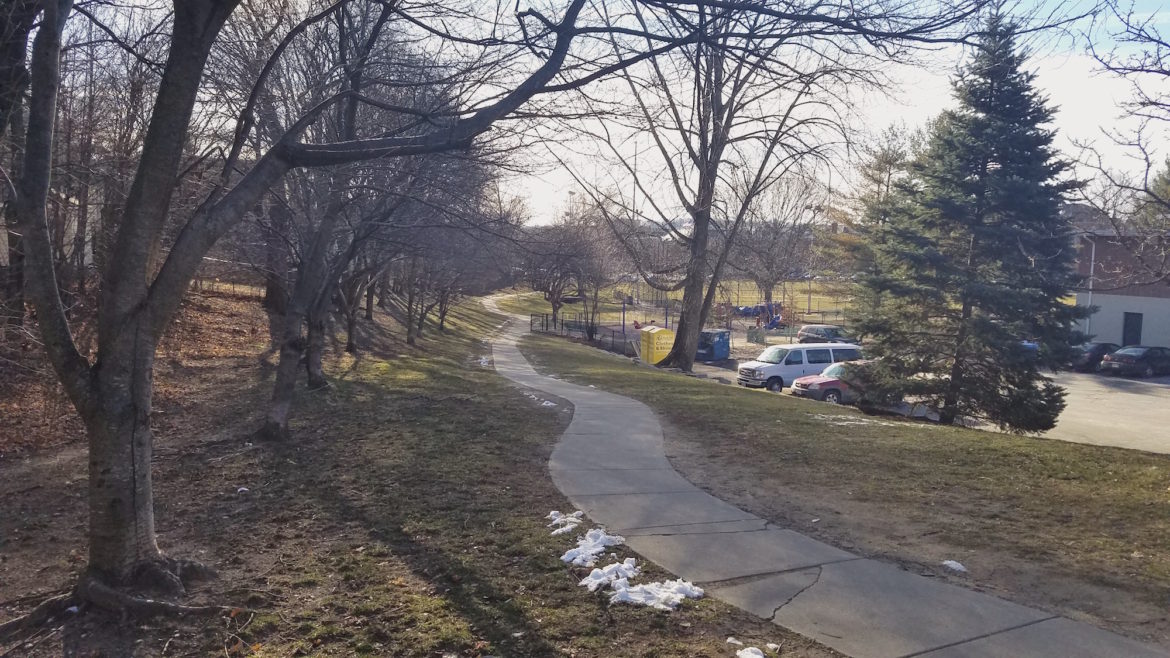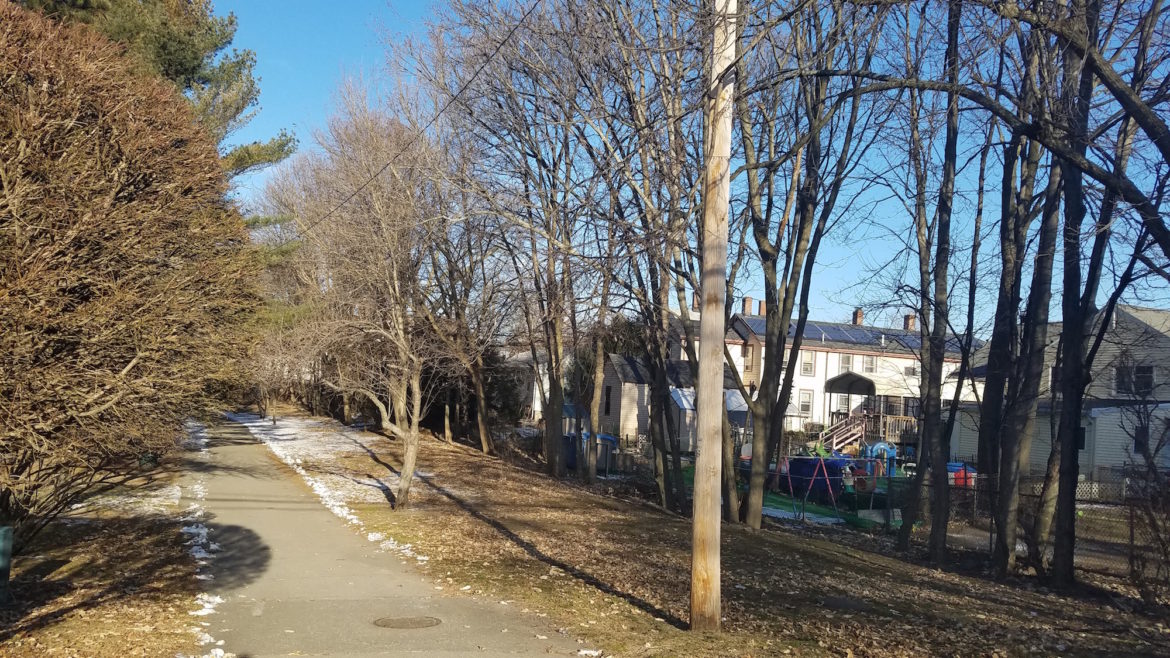
Charlie Breitrose
Some of the trees on the north side (to the left) of Linear Park – behind Town Hall – will be removed because they sit on top of a water main owned by Cambridge.
Unbeknownst to many in Watertown, 20 foot wide piece of land stretching from one end of town to the other is actually owned by the City of Cambridge, and that area has become a source of confusion and controversy now that Cambridge announced the removal of trees on the land that sits above a large water pipe.
The water main, 4 to 5 feet in diameter, connects Cambridge to one of its main water sources – a reservoir in Waltham. Over the years, trees have grown over the pipe and the roots of some have infiltrated the pipe.
The Cambridge Watertown Department informed Watertown Tree Warden Chris Hayward at the end of January that 25 trees will be removed from the area along Linear Park (behind Town Hall) and along the Community Path between Whites Avenue and Waverley Avenue. The work will take place between Feb. 6 and Feb. 10. All of the trees removed will be from Cambridge’s property, Hayward said, and none on Watertown land will be removed.
“It is definitely unfortunate,” Hayward said. “For me, as tree warden, I am unhappy to see it happen, but in reality if it wasn’t done there could be threats to public safety.”
The pipe could break due to root infiltration, or if a large limb from a tree fell on the water main and cause flooding, Hayward said. The trees removed will not be replaced, he said, so that similar problems do not arise in the future.
The trees sit north of the path, and those that will be removed have been marked, Hayward said. Not all the trees in these areas will be impacted.
“We have a line of cherry trees along Linear Path, planted in 2001-02,” Hayward said. “Those are on Watertown property and will not be cut down.”

Some trees along the Community Path between Whites Avenue and Waverley Avenue have been marked for removal by the City of Cambridge’s Water Department.
The Pipeline
While the focus of the tree removals and other maintenance will be on the path behind Town Hall and stretching between Whites and Waverley avenues, that is just the beginning. More trees growing near the pipe where it runs through other parts of town will be removed, Hayward said.
The pipe was put in during the 1800s, Hayward said, and runs along what was the Boston & Maine Railroad tracks.
It runs through Watertown beginning on the Eastside at Mt. Auburn Street, near the Shaw’s, then it goes past Newlywed Foods on Grove Street. The pipe stretches down along the Community Path that goes from Arlington Street, behind the Watertown Mall to School Street and then runs along Arsenal Street.
The pipe runs behind what will be Elan Watertown (at Irving Street/Arsenal Street) and then moves over to cross Mt. Auburn Street in Watertown Square at Baptist Walk, under the Municipal Parking Lot by CVS, and behind the library, where it connects to the area to be worked on: Linear Park and the Community Path west of Whites Avenue.
After it hits Waverley Avenue, it crosses Main Street near the Halfway Cafe, goes down Acton Street, and moves over to Waltham Street and into the City of Waltham.
While much of the path runs next to public paths and roads, some of Cambridge’s 20 foot right-of-way sometimes goes through people’s backyards. Some homeowners do not even realize it.
“People have built sheds or even additions to homes on top of the pipe,” Hayward said.
The City of Cambridge has been contacting homeowners whose property the pipe runs through, Hayward said.
“They have starting working with abutters and others are denying (that the right of way is on their property),” Hayward said.
Questions and inquiries can be made to David Kaplan of the Cambridge Water Department at 617-349-4770.
This 20′ wide ribbon of land weaves through what many people thought was their backyards. Given that Cambridge now wants to maintain better access to “their” property and the water supply line, how will the area be remediated for the abutters and the Watertown community? Tree stumps, dilapidated fencing, trash, and poor boundary definition do not enhance this area. Are there any opportunities to improve the community path? Time for a good neighbor policy discussion. And again, while abutters were informed, the wider Watertown community was not. Why not?
There is absolutely no reason why the “wider Watertown community” would be informed; there is no legal reason as to why anyone, from either the Cambridge or Watertown Government, would have to inform the “wider Watertown community” on this matter. You may want to be informed of every single thing happening in Watertown, but the City’s Government may not have the time or resources to accommodate everything you want. Also, Cambridge is removing these trees as a matter of Public Safety and necessity, not for any other benefit. So, there would be no legal reason to request remediation for this action. Perhaps Cambridge and Watertown could possibly work together to make some improvements to the area, but it is certainly not required of them and you should keep in mind that the area is the property of Cambridge and so it is up to them as to what happens with it.
Good for you Elodia. I agree with your questions.
I adore these trees, particularly those along the Linear Path. I’m glad we had all these years to enjoy them, but lines of responsibility for and communication about this property of Cambridge’s could have been clearer and accommodations long ago made so such destruction of mature trees would not diminish to such an extent Watertown’s greenways. One silver-lining that I see: the old RR right of way, which the news article says is also claimed (beneath?) by Cambridge, could be an off street bike path. If Cambridge is removing trees from Irving down to Taylor, or so, what an opportunity for us. Let’s complete the Community Path off street, as the Bike Committee originally hoped and so many recreational users wish. Commuting cyclists at the crack of dawn and at dinner time would also appreciate being separate from auto traffic. With so much being dug up by Cambridge, how can Watertown best use this opportunity to improve –and connect–our Community Paths? Barbara Ruskin
Spoke with a homeowner today. He said he had no knowledge of this nor was there any indication of this situation at the Registry of Deeds when he bought his homes ever years ago. He said Cambridge contacted the abutters about a year ago and then placed survey stakes. About a month ago people were told to move objects and sheds out of the area. Monday the tree cutting starts.
I have walked the area twice and thus have several questions. Who placed the old fencing along the area? I believe Cambridge has a rule that if trees are cut down an equal number of caliper inches in new trees must be replaced. Trying to check this out. Would this pertain to this property in Watertown? I agree that public safety comes first but after many years of neglect, and it appears some confusing circumstances for abutters, this should be addressed in a way that works out for both cities. Cambridge needs clear access; Watertown wants to extend the community path; homeowners have stakes going through their backyards. Do they deserve a proper fence line? Another question – what square footage have homeowners been paying taxes on? Is Cambridge paying taxes on the property they own? A messy situation for sure.
Thanks for the comment Elodia. From what Tree Warden Chris Haywards told me they won’t be replacing the trees because they could damage the pipes. The question about the fencing is a good one and I have no idea.
Clearly trees would not be planted on the Cambridge access path/road over the pipe. But, given the tree canopy that is being lost it would be great if restitution monies would be appropriated by Cambridge to replace “caliper” inches that will be lost along Linear path to enhance the area. Sustainable and appropriately sited green infrastructure is an important component of any community path, our parks, and our streets. I would love to see some proactive community-wide education, discussion, and planning around this issue given all the development, road reconstruction, and park upgrades going on in town. Thanks so much for the article Charlie. Well done!
The existence of substantial shade trees on Cambridge property along Watertown’s Linear Park may be an accidental result of long term benign neglect by Cambridge, but the positive environmental and community contributions of these trees are very real and quantifiable.
Regarding the asserted necessity to take them down, I must question how likely it is that shade trees, which typically have a maximum root depth of 18 inches, can damage a water main that is reportedly 8 – 10 feet underground. Ditto for damage from falling branches.
Cambridge is undertaking takedown of these trees, and official Watertown is acquiescing, with no acknowledgement of the extent of negative impact this large-scale degradation of green infrastructure will have in the heart of Watertown: damage to wildlife corridor, elimination of cooling summer shade for neighboring homes, the loss of natural interest and calming beauty which these tall trees have provided for pedestrians taking this quiet path through the congested center of Watertown.
Cambridge understands well the valuable infrastructural role urban trees play in managing stormwater and in cooling urban hardscape in summer, as well as in providing beauty and a restorative connection with nature for its citizens. Official Cambridge takes pains to preserve shade trees within its own town borders. Not so much when it comes to its property here in Watertown. Nor does official Watertown seem to understand what is being lost.
You have raised a very good question as to whether it is a necessity to take down the trees over the Cambridge water pipe. I hope that you will be bringing this question to the Cambridge and Watertown officials, so they can explain their reasoning as to why these trees must be taken down. The article does state that “the roots of some have infiltrated the pipe”, but based on your comments, I now wonder if this accurate information. It will be very unfortunate if we were to lose these trees unnecessarily.
Agree with above comments. As an abutter, we strongly oppose to take those trees down. Those trees been there for so many years. At segments where the pipes are now damaged, why the trees need to be cut down. Even for the mature canopy trees, their roots do not usually go deeper than 3 feet. Therefore at places pipes are not damaged, most likely it will not be damaged in the future by trees. It would be ridiculous to cut trees down.
Where is our Watertown Tree Warden? It is arguable itself the statement that tree roots damage the pipes! Depending on how deep the pipes are, trees may do nothing to it. As a landscape architect, we know the common practice for the existing tree pipe conflict is to exam the pipe condition, and only remove trees at the spots where pipes are impacted and fix the pipes. If the pipes and trees are getting along for all these years, there is absolutely no need to remove trees! What a shame!
This is the perfect blog for anyone who wants to know about this topic. The article is nice and it’s pleasant to read. I have known very important things over here. Thank you so much for this post.